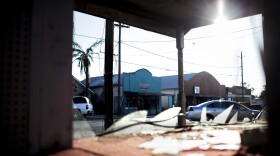From Texas Standard:
Up and down the Gulf Coast, Texans are still trying to get back to where they were before Hurricane Harvey hit. Some have had to rebuild from the ground up. For others, the trouble is with the ground itself.
Fifty miles south of Houston in Brazoria County, Jessica Chase and Brady Stark are examining a piece of grass they found in Stark’s pasture.
“This came in with Harvey. It’s a summer annual weed and it can reach up to three-and-a-half feet tall – yours are getting close,” Chase says.
Chase is a Texas A&M Agrilife extension agent for Brazoria County. One of her jobs is to help landowners like Stark keep their pastures in good shape: identifying weeds like the Pennsylvania Smartweed she and Stark are looking at, and suggesting herbicides and fertilizers.
And that’s important work in Brazoria County. It’s an exceptionally green place, where people raise cattle and horses, rice and sorghum. Stark’s been here since 1995. Over that time, he’s worked hard to keep his pastures in good shape for the cattle he raises. And they were in good shape until Hurricane Harvey.
“After Harvey it was like, about a foot to maybe 16 inches deep. All over. I had water in the barns, but not in the house,” Stark says.
His cattle were fine, but the pastures sat underwater for two weeks. They were caked in mud for another month after that. And once the mud washed off, the weeds came. Stark’s been able to get rid of a lot of them, but a ride around his property shows there’s still plenty left – with new species continuing to pop up. As we drive around to the backside of his pond, something catches Chase’s eye.
“Did you have this thistle before Brady?” Chase asks.
Chase is talking about a patch of plants that all have thin, spiny stems with equally prickly bulbs on top.
“Now that you mention it I’ve seen several patches of this too,” Stark says.
“I’ve seen several patches of it around. It is a thistle, I believe it’s blessed milk thistle. So that’s another one that’s been popping up also,” Chase says.
Rains from Hurricane Harvey acted like a conveyer belt for weeds. As rivers, creeks and bayous breached their banks, they carried plant material with them. The water sitting over pastures like Stark’s became a soupy slurry of seeds.
“Basically whatever your neighbors had that you worked so hard to keep off of your land – or the neighbor two miles up the road – is now on your property because that water just floated it all across,” Chase says. “So basically everything that everybody had in the county is mixed all over the place.”
Repairing pastures is expensive and time-consuming. But if you’re trying to raise livestock, you’ve got to do it. Cattle and horses usually won’t eat weeds, and even if they did, they wouldn’t get nearly the nutritional value they would from eating grass. Some weeds, like Snow on the Mountain – a species that has thrived after Harvey – are even toxic to cattle.
Now many pastures affected by the storm have recovered. But others are still in bad shape, maybe too far gone to be salvaged. As I was driving around Brazoria County, I stopped to take a closer look at a property just outside Angleton, the county seat. The place was surrounded by a barbed wire fence and had a cattle guard leading up to the driveway. There are no cows. And the reason for that is that weeds have completely and totally taken over the pastures. All the grassy area around the house, which I would estimate probably comprises 15 to 20 acres, it is entirely weeds.
Some of them came up to my waist, others were over my head. It’s a fate that Kevin Reifel’s been trying to avoid on his own land. He drove me over to take a look at some property between the San Bernard and Brazos rivers. He keeps a few horses on it, and he and his brother *used to raise cattle there too.
“This was our main pasture and we have sold all the cows off of it,” Reifel’s says.
The plot that was once thick with healthy Bermuda grass is now empty except for scrubby, spiny stands of weeds in between patches of mud. Reifel’s brother’s house flooded during the storm. He’s building a new one – this time raised up on 12 foot beams. But they had to sell their cattle after Harvey because they couldn’t take on both rebuilding a house and a pasture. To get it back in order, they’ll have to start over: till up the field, spray herbicides for all the weeds, and then replant the grass. Reifel knows better than most how much that will cost. He owns the local feed and ranch supply store in the city of Brazoria, so he’s had a big part in getting people what they need to get back to normal.
“Grass seed, grass seed, grass seed – that a lot. Insecticide, herbicides, and feed. So just about everything that I sell, they’ve been buying,” Reifel says.
Harvey’s been a boon for Reifel’s business he wishes never happened. In his part of Texas, the struggle against weeds and loss of good grass could go on for years. Because even though you might kill a weed above ground, it could still be alive below the surface. So for people like Brady Stark, getting back to normal will take time…
“But I’ll get back. Just don’t know when,” says Brady Stark.





